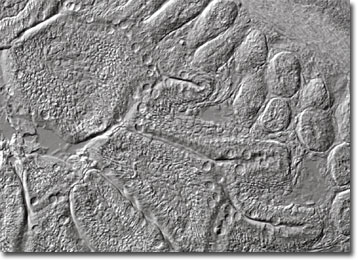Differential Interference Contrast Image Gallery
Intestine Thin Section
The digestive systems of most higher-level animals have the same basic components: mouth, pharynx, esophagus, stomach, small intestine, and large intestine. The relative importance and specific characteristics of each component, however, are highly dependent upon the typical diet of the species.

Depending upon their composition, different types of food take varying times to process in each area of the alimentary canal. Starch and sugar, for instance, are held in the stomach for a much shorter amount of time than proteins and fats. This is why eating a heavy breakfast, like bacon, eggs, and toast, generally satisfies one’s hunger longer than a bowl of sugarcoated cereal. Since the primary function of the small intestine is to dissolve nutrients from food and release them into the bloodstream through its walls, nutrient-rich foods generally spend a longer period of time in this part of the digestive tract. The large intestine, on the other hand, is more concerned with absorbing water from food and preparing indigestible waste for release from the body.
In humans, the most prominent structure of the digestive system is the small intestine, which is generally more than 20 feet long. In nonhuman primates, however, the large intestine is a more central component to the digestive process. This divergence between humans and creatures such as gorillas and orangutans reflects the vast differences in their diets. As omnivores, humans generally consume high quality foods that contain significant amounts of protein, fats, and carbohydrates. The slower moving, nonhuman vegetarian primates, however, eat lower quality plants that contain a higher proportion of roughage.
